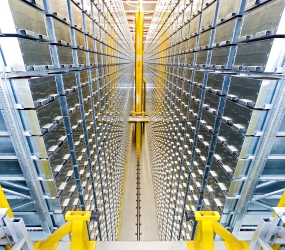Macquarie University Library is the first Australian library to use an Automated Storage and Retrieval System (ASRS) to help house its entire physical collection. This innovative storage solution allows library floor space to be utilised for student study rather than shelf space. Librarian Insider speaks with Brendan Krige of Macquarie University Library to find out more about the impact the storage system has had on the library and its patrons.
Why did you decide to invest in the ASRS?
We wanted to build a library that was ‘client-centric’ rather than ‘library-centric’ and a key aspect of this was to move our focus from physical collections to the provision of effective learning spaces that would meet the demands presented by increasing student numbers and their changing information needs.
A high-density on-site ASRS would use only one seventh the floor space of traditional shelving, and with only 20% of our collection satisfying 80% of loans, it made sense to place the lesser used items into an ASRS. Simply put, an ASRS would free up a huge amount of space for people.
Other attractive features of having an ASRS were:
- If all our collection was held on traditional shelving we would have needed to build an extra 11,000 sqm of floor space to accommodate it. This has significant sustainability implications for our ecological footprint. A smaller building means less use of water, electricity and other consumables.
- The ASRS allows all our collection to be held on-site and be immediately available via online request.
- The ASRS is a climate-controlled vault providing optimum temperature and humidity for the long-term preservation of items.
- Analysis of ASRS systems already in place in libraries showed they are cost effective both in terms of installation and on-going maintenance.
How did you promote the installation of the new storage system to patrons?
We held a ‘Robot Party’ to publicise the coming ASRS and the concept of robotic retrieval of book spread quickly around the University community. As ours was to be the first ASRS in Australia, the concept was also picked up by some Sydney and industry media.
A lengthy consultation process with academics was undertaken to determine our ‘Collection Storage Principles’ (i.e. what items would go into the ASRS and what items would remain on open shelves).
Once items began to be loaded into the ASRS, an education campaign was implemented to show users how to retrieve items. Concerns about the loss of serendipitous browsing were addressed, and a virtual bookshelf was created within the catalogue allowing users to see the print and electronic resources around a particular item by call number.
How much time does the process take from request to collection?
The retrieval process is completed in just minutes. The catalogue interacts directly with the ASRS software and as soon as a user requests an item the robotic crane swings immediately into action, retrieving the bin containing the item.
We tell users that request retrievals can take up to half an hour before they will be ready for collection but in practice they are usually available within 10 minutes.
Has it encouraged patrons to visit the library to use the system?
The ASRS has been a drawcard for visitors to the University and library, and we have run hundreds of tours showing how the system works.
Whether it has encouraged patrons to use the system is difficult to say. However, we can say that the ASRS has not been an impediment to discovery or access, as over 5214 ASRS items with a publication date prior to 2006 have circulated for the first time since July 2011.
Has the increased floor space encouraged more patrons to study in the library?
Unequivocally yes. Our old library, which was almost identical in terms of square metres, had 1200 seats and 100 PCs. The ASRS has allowed us to double both those figures (2500 seats, 200 Pcs), and within two weeks of opening the new library was already at capacity.
Our door count went from 5,500 visits per day in the old library to up to 10,000 visits per day in the new one.
What impact has it had on the role of the librarians?
While the ASRS itself has had little impact on librarians, the move to a new ‘client-centred’ physical environment created a unique opportunity to build a client-centred organisation and culture to complement it.
Certainly the new ASRS has meant that library staff, including shelvers, have had to learn how to operate the ASRS system to retrieve and store items.
Does this storage system encourage your institution to continue to purchase paper copies of research rather than switching to electronic-only versions?
The ASRS means we do not feel the pressures of space for our collection that many other libraries do.
The library has an e-preferred acquisitions guideline; however, print resources will be added if that is the most appropriate format for that resource. In 2012, 80% of our resources budget was spent on electronic resources.
